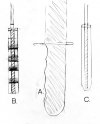- Joined
- Nov 5, 2004
- Messages
- 280
Howdy,
I've got a buddy that wants me to make a bowie for him. It's not a conventional bowie however, as it has a finger grooved full tang blade. Being a rather large bowie, it's neccessary for it to have a guard on it. Unfortunatly, I'm beat as to how to get one on. I've attatched a rough sketch to better explain my question.
Part A. shows the handle of the knife from the side without any handle scales. The shaded part is the actual tang. Part B. and C. are looking at the finger grooves and the spine, respectively. Again, the shaded area is exposed metal.
Due to the design, there is not enough metal to create a guard out of the tang and place a bolster over it. Because the handle and blade are almost the same width, how do I get a guard to go on and stay on?
I considered slotted guards, but I'd prefer a double-sided guard, so that's kinda out.
Thanks for the help!
~Brian
I've got a buddy that wants me to make a bowie for him. It's not a conventional bowie however, as it has a finger grooved full tang blade. Being a rather large bowie, it's neccessary for it to have a guard on it. Unfortunatly, I'm beat as to how to get one on. I've attatched a rough sketch to better explain my question.
Part A. shows the handle of the knife from the side without any handle scales. The shaded part is the actual tang. Part B. and C. are looking at the finger grooves and the spine, respectively. Again, the shaded area is exposed metal.
Due to the design, there is not enough metal to create a guard out of the tang and place a bolster over it. Because the handle and blade are almost the same width, how do I get a guard to go on and stay on?
I considered slotted guards, but I'd prefer a double-sided guard, so that's kinda out.
Thanks for the help!
~Brian

